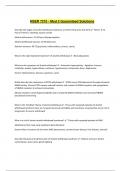NSER 7210 - Mod 2 Guaranteed Solutions
Describe the stages of alcohol withdrawal syndrome, and the timing since last drink ✔️Minor: 6-12
hours (Tremors, sweating, nausea, tachy)
Alcohol hallucinosis: 12-24 hours (Dysperception)
Alcohol withdrawal seizures: 24-48 (Seizures)
Delirium tremens: 48-72 (psychosis, hallucinations, seizure, coma)
What is the "gold standard treatment" of alcohol withdrawal ✔️Benzodiazepines
What are the symptoms of alcohol withdrawal ✔️Autonomic hyperactivity - Agitation, tremors,
irritability, anxiety, hyperreflexia, confusion, hypertension, tachycardia, fever, diaphoresis,
Severe: Hallucinations, Seizures, psychosis, coma
Briefly describe the mechanism of EOTH withdrawal ✔️ETOH causes CNS depression through enhanced
GABA activity. Chronic ETOH causes reduced function and number of GABA receptors and upregulation
of NMDA receptors to achieve homeostasis.
Abrupt cessation causes hyperexcitability due to impaired GABA (inhibition) and increased NMDA
(excitatory) functioning
What is the "Kindling" theory of alcohol withdrawal ✔️Those with repeated episodes of alcohol
withdrawal syndrome have an increased neuronal excitability and sensitivity, meaning they are at risk of
progression to severe withdrawal
Who is at risk of severe alcohol withdrawal syndrome? ✔️Those with repeated episodes of AWS
Medications that mask early symptoms (beta blockers)
Severe illness increases risk of severe AWS (pneumonia, coronary heart disease, liver disease, anemia)
Describe the general treatment plan of alcohol withdrawal syndrome ✔️Reduce stressors: Gentle
reorientation, quiet room, gentle lighting
, Correct fluid depletion, hypoglycemia and lyte and vitamin disturbances
Benzo's are only med with proven efficacy, several others being studied (Sodium oxybate, propofol)
Potential adjuncts (Beta blockers, barbituates, clonidine, gabapentin, neuroepileptics)
Define SIRS ✔️An overwhelming, unregulated inflammatory response
Results in uncontrolled coagulation, widespread vessel leakage, poor distribution of circulating volume
Explain qSOFA for assessment of Sepsis ✔️Quick Sequential Organ Failure Assessment
RR >22
Change in mental status
Systolic BP < 100 mmHg
State the 5 risk factors for severe sepsis ✔️Looks unwell
Age >65
Recent surgery
Immunocompromised
Chronic illness (Diabetes, renal failure, cancer, ETOH)
State the SIRS Criteria ✔️2 or more of the following
HR > 90
RR > 22
Temp > 38 or < 36
WBC > 12,000 or < 4,000
State the hallmark symptoms of septic shock and brief patho ✔️Warm, flushed skin - Exaggerated
inflammatory response causing vasodilation
Depleted intravascular volume with normal total fluid volume , fluid distributed where it cant be
accessed
Early malfunctioning of coagulation and depleted clotting factors = bleeding




